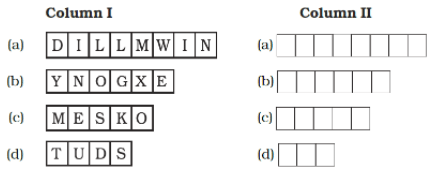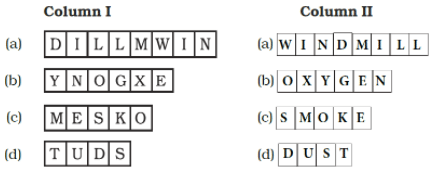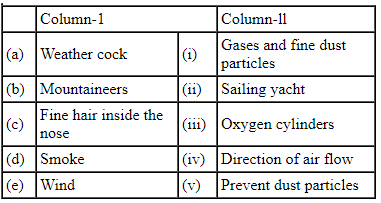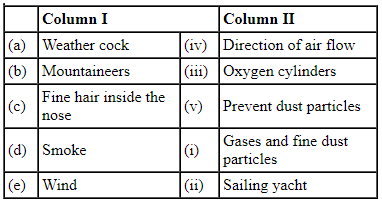NCERT Exemplar Solutions: Air around Us | Science for Class 6 PDF Download
| Table of contents |

|
| Multiple Choice Questions |

|
| Very Short Answer Questions |

|
| Short Answer Questions |

|
| Long Answer Questions |

|
Multiple Choice Questions
Q1: Which of the following statements is incorrect?
(a) All living things require air to breathe.
(b) We can feel air but we cannot see it.
(c) Moving air makes it possible to fly a kite.
(d) Air is present everywhere but not in soil.
 View Answer
View Answer 
Ans: (d)
Air is omnipresent in nature and is present everywhere including soil. This can be proved by a simple activity.
By taking a lump of dry soil in a beaker or a glass, add water to the soil, we can see that the soil has absorbed the water in the form of bubbles.
Q2: Wind does not help in the movement of which of the following?
(a) Firki
(b) Weathercock
(c) Ceiling fan
(d) Sailing yacht
 View Answer
View Answer 
Ans: (c)
Wind does not help in the movement of ceiling fan since ceiling fan moves by electricity.
Q3: What is not true about the air?
(a) It makes the windmill rotate.
(b) It helps in the movements of aeroplanes.
(c) Birds can fly due to the presence of air.
(d) It has no role in the water cycle.
 View Answer
View Answer 
Ans: (d)
Air plays a major role in the water cycle. Water vapours are risen up to form clouds.
Q4: Mountaineers carry oxygen cylinders with them because
(a) there is no oxygen on high mountains
(b) there is a deficiency of oxygen on mountains at high altitude
(c) oxygen is used for cooking
(d) oxygen keeps them warm at low temperature.
 View Answer
View Answer 
Ans: (b)
As higher we go, the atmosphere gets thinner and the supply of oxygen is reduced. This makes difficulty in breathing on hill stations and mountains. Therefore, while climbing high mountains, mountaineers carry oxygen cylinders with them.
Q5: Boojho took an empty plastic bottle, turned it upside down and dipped its open mouth into a bucket filled with water. He then tilted the bottle slightly and made the following observations.
(i) Bubbles of air came out from the bottle.
(ii) Some water entered the bottle.
(iii) Nitrogen gas came out in the form of bubbles and oxygen got dissolved in water.
(iv) No bubbles formed, only water entered the bottle.
Which observations is/are correct?
(a) (i) and (ii)
(b) (iv) only
(c) (iii) and (iv)
(d) (i) only
 View Answer
View Answer 
Ans: (a)
Bubbles of air came out from the bottle. Some water entered the bottle.
Q6: Which of the following components of air is present in the largest amount in the atmosphere?
(a) Nitrogen
(b) Oxygen
(c) Water vapour
(d) Carbon dioxide
 View Answer
View Answer 
Ans: (a)
The atmosphere contains nitrogen in the largest amount. It mainly constitutes 78% of nitrogen, 21% of oxygen and the remaining 1% is formed by carbon dioxide, water vapour, few other gases and dust particles.
Q7: The components of air which are harmful to live beings are
(a) nitrogen and carbon dioxide
(b) dust and water vapour
(c) dust and smoke
(d) smoke and water vapour.
 View Answer
View Answer 
Ans: (c)
Water vapour is important for the water cycle in nature.
Nitrogen is necessary for plants.
Carbon dioxide is essential for photosynthesis.
Hence, dust particles and smoke coming out of factories are very harmful to living beings.
Q8: Usha took a lump of dry soil in a glass and added water to it till it was completely immersed. She observed bubbles coming out. The bubbles contain
(a) water vapour
(b) only oxygen gas
(c) air
(d) none of these.
 View Answer
View Answer 
Ans: (c)
When the water is poured on the lump of soil, the soil absorbs the water in the form of bubbles.
Very Short Answer Questions
Q9: State whether the following statements are true or false. If false, correct them.
(a) Plants consume oxygen for respiration.
(b) Plants produce oxygen during the process of making their own food.
(c) Air helps in the movements of sailing yachts and gliders but plays no role in the flight of birds and aeroplanes.
(d) Air does not occupy any space.
 View Answer
View Answer 
(a) True
(b) True
(c) False – Air helps in the movement of sailing yachts and gliders and also helps in the flight of birds and aeroplanes.
(d) False – Air does occupy space.
Q10: In a number of musical instruments, air plays an important role. Can you name such instruments?
 View Answer
View Answer 
Air plays an important role in a number of musical instruments such as mouth organ, harmonium, shehnai, trumpet, trumpet and flute.
Q11: In the boxes of a column I the letters of some words got jumbled. Arrange them in proper form in the boxes given in column II.
 View Answer
View Answer 
Here are the arranged words:
Q12: Make sentences using the given set of words.
(a) 99%, oxygen, nitrogen, air, together
(b) Respiration, dissolved, animals, air, aquatic
(c) Air, wind, motion, called
 View Answer
View Answer 
(a) 99% of the air is made up of Oxygen and nitrogen together.
(b) Aquatic animals use dissolved air for respiration.
(c) The air in motion is called wind.
Short Answer Questions
Q13: A list of words is given in a box. Use appropriate words to fill up the blanks in the following statements.
[Air, oxygen, wind, water vapour, mixture, combination, direction, road, bottles, cylinders]
(a) The ______ makes the windmill rotate.
(b) Air is a ______ of some gases.
(c) A weathercock shows the in which the air is moving at that place.
(d) Mountaineers carry oxygen ______ with them while climbing high mountains.
 View Answer
View Answer 
(a) wind
(b) mixture
(c) direction
(d) cylinders
Q14: Observe the picture given in Fig. 15.1 carefully and answer the following questions. (a) What is covering the nose and mouth of the policeman?
(a) What is covering the nose and mouth of the policeman?
(b) Why is he putting a cover on his nose?
(c) Can you comment on air quality of the place shown in the Fig.15.1?
 View Answer
View Answer 
(a) The policeman has worn a mask to cover his nose and mouth.
(b) He has put a mask on his nose to protect himself from dirt and polluted air. Since the mask avoids exposure to the harmful exhaust of vehicles, thus prevents the harmful gases and dust particles entering our body.
(c) In the given figure the quality of air is bad since it is polluted. Due to the smoke and harmful gases such as carbon monoxide and sulphur dioxide emitted by the automobiles along with dust particles the air is polluted.
Q15: Garima observed that when she left her tightly capped bottle full of water in open sunlight, tiny bubbles were formed all around inside the bottle. Help Garima to know why it happened?
 View Answer
View Answer 
When the air gets dissolved in water it escapes in the form of tiny bubbles due to heat from the sun. Hence, tiny bubbles were formed all around inside the bottle.
Q16: Match the items of Column I with the items of column II.
 View Answer
View Answer 
Here is the correct match:
Long Answer Questions
Q17: Explain the following observations very briefly.
(a) A firki does not rotate in a closed area.
(b) The arrow of weathercock points towards a particular direction at a particular moment.
(c) An empty glass, in fact, is not empty.
(d) Breathing through the mouth may harm you.
 View Answer
View Answer 
(a) In a closed area, there is a lack of air movement which does not support the rotation of a firki. A firki usually rotates when placed in an open area due to the moving air present all around.
(b) A weathercock is an instrument used to indicate the direction of the wind. It consists of an arrow, mounted at its centre of gravity for it to move freely about a vertical axis. Hence, the arrow points towards a particular direction at a particular moment to show the latest direction of the wind movement.
(c) An empty glass is not empty it is filled with air. It can be proved with a simple experiment in which an empty bottle is turned upside down in a beaker filled with water. The water does not enter the bottle when it is pushed in an inverted position because there is no space for air to escape. When the bottle is tilted, the air is able to escape out in the form of bubbles and water fills up the empty space. This shows that even an empty glass is filled with the air.
(d) Yes, breathing through the mouth may harm us. Some gases, water vapour and dust particles may be present in the air. When we inhale air through nostrils, the fine hair and mucus present in the nose prevent the dust particles from entering the respiratory tract. But, if we breathe through the mouth, the harmful dust particles may enter our body and make us ill. Thus, breathing through the mouth may harm us.
Q18: Write just a few sentences for an imaginary situation if any of the following gases disappear from the atmosphere.
(a) Oxygen
(b) Nitrogen
(c) Carbon dioxide
 View Answer
View Answer 
(a) If oxygen gas disappears from the atmosphere, life becomes impossible on earth since oxygen is very essential for the survival of the living organisms. Animals and plants take in oxygen from the atmosphere and release carbon dioxide during respiration. It becomes impossible for living organisms to breathe in the absence of oxygen and hence, eventually, the organisms will die so oxygen is very necessary.
(b) Nitrogen constitutes a major part of the atmosphere and it does not support burning. If nitrogen gas disappears from the atmosphere, things on earth will burn very fast which may produce disastrous results. Plants require nitrogen for their growth, although it does not absorb nitrogen directly from the air. They consume it in the soluble form either through fertilizers which can be absorbed through the soil. Hence, nitrogen is very important for plants, animals, humans and other organisms to grow properly.
(c) Plants require carbon dioxide to manufacture their own food by the process of photosynthesis. If carbon dioxide disappears from the atmosphere, the plants will not be able to produce their food and oxygen will not be released by them which will disturb the carbon dioxide – oxygen ratio in the atmosphere. Hence, in the absence of oxygen and food, there will be no life on earth.
Q19: Paheli kept some water in a beaker for heating. She observed that tiny bubbles appeared before the water started to boil. She boiled the water for about 5 minutes and filled it in a bottle up to the brim and kept the bottle airtight till it cooled down to room temperature.
(a) Why did the tiny bubbles appear?
(b) Do you think tiny bubbles will appear on heating the water taken out from the bottle? Justify your answer.
 View Answer
View Answer 
(a) The tiny bubbles appeared before the water started to boil since the air dissolved in water. Once the water started to boil, the air dissolved in water escaped in the form of bubbles.
(b) Paheli had boiled the water completely where the air from the water had escaped out, so on reheating the cooled boiled water will not make any tiny bubbles as there is no air present in it.
Q20: On a Sunday morning, Paheli’s friend visited her home. She wanted to see some flowering plants in the nearby garden. Both of them went to the garden. While returning from the garden they also observed some flowering plants on the roadside. But to their surprise, they found that the leaves and flowers of these roadside plants were comparatively very dull. Can you help them to know why
 View Answer
View Answer 
The dull appearance of the leaves and flowers of the roadside plants may be due to the air quality present in the open area which includes dust particles emitted from the vehicles, chimneys and factories. These dust particles stick to the plant parts which made them appear dull.
|
69 videos|288 docs|27 tests
|
FAQs on NCERT Exemplar Solutions: Air around Us - Science for Class 6
| 1. What is the composition of air? |  |
| 2. Why is air important for living organisms? |  |
| 3. How does air pollution affect health? |  |
| 4. What are the major sources of air pollution? |  |
| 5. How can we reduce air pollution? |  |















